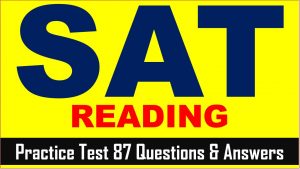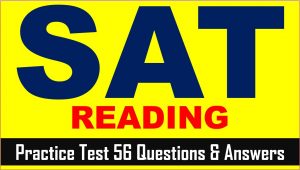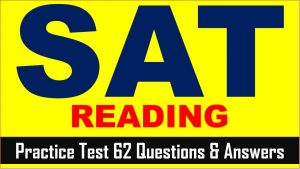SAT (Scholastic Assessment Test) is a standard test, used for taking admission to undergraduate programs of universities or colleges of the United States. SAT is developed and published by the College Board, an organization in the United States, administered by the Educational Testing Service. In this article of AKVTutorials, you will get Kaplan SAT Prep Test Course Book Review | Practice Test 20 AMBiPi.
Kaplan SAT Prep Test Course Book Review
According to the report, thousands of high scholars scores maximum in SAT test by reading Kaplan SAT course.
Now, is Kaplan SAT courses best for SAT preparation after all of these track record and success rate of SAT candidates?
Yes or No.
Let’s review Kaplan SAT Test Prep Course in this article.
Check Price On Amazon
And, after reading this article, you will find that Kaplan SAT prep course is best for SAT exam or NOT.
Kaplan SAT Prep Course Options and Pricing
From the official website of Kaplan SAT prep company, you find that Kaplan provides three types of SAT course names as SAT One Demand, SAT Live Online and SAT Unlimited Prep, given as below.

For Updated Kaplan SAT Prep Course, Check its Official Website.
Check Price On Amazon
But, on this article of AKVT, there is a review of Kaplan SAT prep plus book.
SAT test is NOT a tough exam. To crack SAT test, you just need of focus and practice.
The best part of this Kaplan SAT Prep plus book is that its chapters topics and practice papers are very close to real SAT exam.
Since College Board schedules SAT test dates seven times in a year and you are not sure about when you should you give SAT test and for which when you should the SAT preparations, then Kaplan provides a SAT prep plus book.
Check Price On Amazon
In this SAT prep book, there are following sections are made in each chapter.
- A section of set of questions known as “How Much Do You Know?” which helps you identify your previous knowledge.
- A section of set of questions known as “Try on Your Own”, where you practice on a concept or a particular topic of the chapter.
- The section of “Check Your Work” includes the answer and explanation of the SAT practice questions.
- This section of “How Much Have You Learned?” is the end of chapter where you will get a complete set of SAT practice questions.
SAT Reading Practice Passage
This passage is adapted from Carolyn Gramling, “Source of Mysterious Medieval Eruption Identified.” ©2013 by American Association for the Advancement of Science.
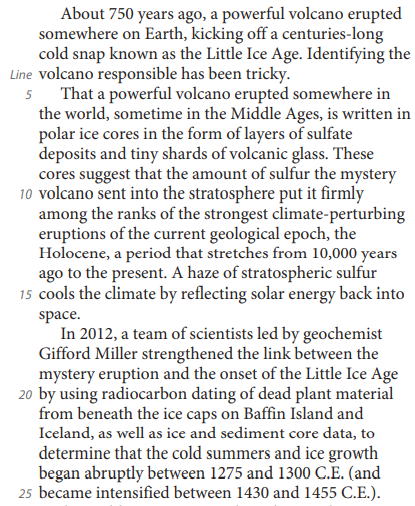
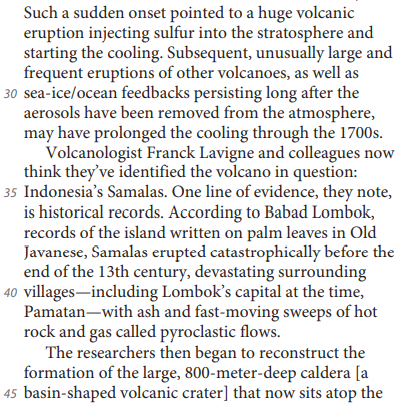
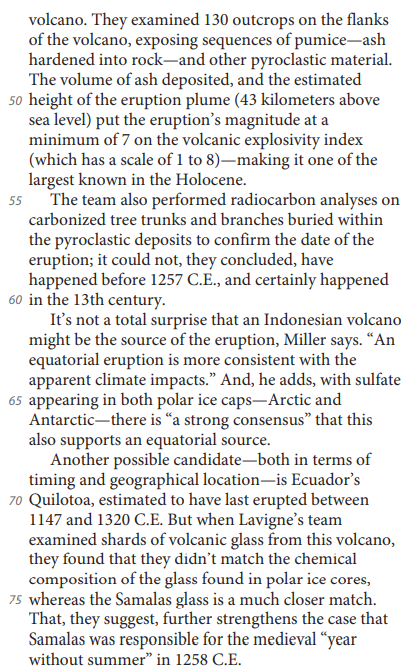
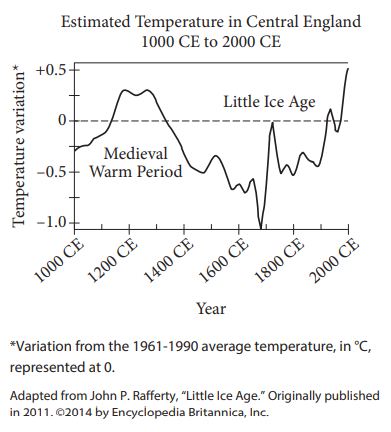
SAT Reading Comprehension Practice Test Questions
SAT Practice Test 20 Question No 1
The main purpose of the passage is to
Option A: describe periods in Earth’s recent geologic history.
Option B: explain the methods scientists use in radiocarbon analysis.
Option C: describe evidence linking the volcano Samalas to the Little Ice Age.
Option D: explain how volcanic glass forms during volcanic eruptions.
SAT Practice Test 20 Answer No 1
Show/Hide Answer
Option C :
The author explains that a “powerful volcano” erupted around 750 years ago and caused “a centuries-long cold snap known as the Little Ice Age” (lines 1-3). The author then states that a group of scientists believe the volcano Samalas was this “powerful volcano,” and she explains how the scientists’ research supports this claim (lines 17-78).
Choices A, B, and D are incorrect because they do not identify the main purpose of the passage.
SAT Practice Test 20 Question No 2
Over the course of the passage, the focus shifts from
Option A: a criticism of a scientific model to a new theory.
Option B: a description of a recorded event to its likely cause.
Option C: the use of ice core samples to a new method of measuring sulfates.
Option D: the use of radiocarbon dating to an examination of volcanic glass.
SAT Practice Test 20 Answer No 2
Show/Hide Answer
Option B :
The author begins the passage by explaining how the Little Ice Age was a “centuries-long cold snap” that was likely caused by a volcanic eruption (lines 1-3). The author then explains how scientists used radiocarbon analysis to determine when the Little Ice Age began and how a volcanic eruption triggered the cooling temperatures (lines 17-25).
Choices A, C, and D are incorrect because the passage does not criticize a scientific model, offers a new method of measuring sulfates, or shift from the use of radiocarbon dating to an examination of volcanic glass.
SAT Practice Test 20 Question No 3
Which choice provides the best evidence for the answer to the previous question?
Option A: Lines 17-25 (“In 2012… 1455 C.E.”)
Option B: Lines 43-46 (“The researchers… atop the volcano”)
Option C: Lines 46-48 (“They examined… material”)
Option D: Lines 55-60 (“The team… 13th century”)
SAT Practice Test 20 Answer No 3
Show/Hide Answer
Option A :
In lines 17-25, the passage shifts focus from describing a recorded event to providing evidence that the Little Ice Age was likely caused by a volcanic eruption. The passage states that scientists used “radiocarbon dating of dead plant material from beneath the ice caps on Baffin Island and Iceland, as well as ice and sediment core data” to determine when the Little Ice Age began and how it was connected to the “mystery” volcanic eruption.
Choices B, C, and D are incorrect because they do not provide the best evidence that the passage shifts focus from a description of a recorded event to its likely cause. Choices B, C, and D all focus on the scientists’ research but do not explain what caused the Little Ice Age.
SAT Practice Test 20 Question No 4
The author uses the phrase “is written in” (line 6) most likely to
Option A: demonstrate the concept of the hands-on nature of the work done by scientists.
Option B: highlight the fact that scientists often write about their discoveries.
Option C: underscore the sense of importance that scientists have regarding their work.
Option D: reinforce the idea that the evidence is there and can be interpreted by scientists.
SAT Practice Test 20 Answer No 4
Show/Hide Answer
Option D :
According to lines 5-8, “That a powerful volcano erupted somewhere in the world, sometime in the Middle Ages, is written in polar ice cores in the form of layers of sulfate deposits and tiny shards of volcanic glass.” The phrase “is written in” reinforces the idea that the polar ice caps contain evidence of the volcanic eruption and that scientists can interpret this evidence by examining the “sulfate deposits and tiny shards of volcanic glass.”
Choices A, B, and C are incorrect because the author does not use the phrase “is written in” to demonstrate the concept of the hands-on nature of the scientists work, highlight the fact that scientists often write about their work, or underscore the sense of importance scientists have about their work.
SAT Practice Test 20 Question No 5
Where does the author indicate the medieval volcanic eruption most probably was located?
Option A: Near the equator, in Indonesia
Option B: In the Arctic region
Option C: In the Antarctic region
Option D: Near the equator, in Ecuador
SAT Practice Test 20 Answer No 5
Show/Hide Answer
Option A :
The scientists believe the volcano Samalas, located in Indonesia, was most likely the medieval volcanic eruption (lines 33-35). The eruption likely occurred near the equator because an equatorial location is “consistent with the apparent climate impacts” the scientists observed (lines 61-67).
Choices B, C, and D are incorrect because the scientists do not suggest that the medieval volcanic eruption was located in the Arctic region, the Antarctic region, or Ecuador.
SAT Practice Test 20 Question No 6
Which choice provides the best evidence for the answer to the previous question?
Option A: Lines 1-3 (“About 750…Ice Age”)
Option B: Lines 26-28 (“Sucha…the cooling”)
Option C: Lines 49-54 (“The volume…the Holocene”)
Option D: Lines 61-64 (“It’s not… climate impacts”)
SAT Practice Test 20 Answer No 6
Show/Hide Answer
Option D :
In lines 61-64, the author cites geochemist Gifford Miller’s findings that provide evidence that the medieval volcanic eruption most likely occurred in Indonesia near the equator: “It’s not a total surprise that an Indonesian volcano might be the source of the eruption, Miller says. ‘An equatorial eruption is more consistent with the apparent climate impacts.’”
Choices A, B, and C are incorrect because they do not provide evidence that the medieval volcanic eruption most likely occurred in Indonesia near the equator. Rather, choices A, B, and C focus on the medieval volcano’s power, impact, and magnitude.
SAT Practice Test 20 Question No 7
As used in line 68, the phrase “Another possible candidate” implies that
Option A: powerful volcanic eruptions occur frequently.
Option B: the effects of volcanic eruptions can last for centuries.
Option C: scientists know of other volcanoes that erupted during the Middle Ages.
Option D: other volcanoes have calderas that are very large.
SAT Practice Test 20 Answer No 7
Show/Hide Answer
Option C :
In lines 68-71, the author states, “Another possible candidate—both in terms of timing and geographical location—is Ecuador’s Quilotoa, estimated to have last erupted between 1147 and 1320 C.E.” The phrase “another possible candidate” implies that the scientists believe that in the Middle Ages a different volcanic eruption, such as an eruption from the volcano Quilotoa, could have been responsible for the onset of the Little Ice Age.
Choices A, B, and D are incorrect because the phrase “another possible candidate” does not imply the frequency or effects of volcanic eruptions, or that some volcanoes have large calderas.
SAT Practice Test 20 Question No 8
Which choice best supports the claim that Quilotoa was not responsible for the Little Ice Age?
Option A: Lines 3-4 (“Identifying… tricky”)
Option B: Lines 26-28 (“Sucha… cooling”)
Option C: Lines 43-46 (“The researchers… atop the volcano”)
Option D: Lines 71-75 (“But… closer match”)
SAT Practice Test 20 Answer No 8
Show/Hide Answer
Option C :
In lines 71-75, the author explains how Lavigne’s team proved that Quilotoa’s eruption did not cause the Little Ice Age. “But when Lavigne’s team examined shards of volcanic glass from this volcano, they found that they didn’t match the chemical composition of the glass found in polar ice cores, whereas the Samalas glass is a much closer match.” These findings show that Samalas, not Quilotoa, was responsible for the onset of the Little Ice Age.
Choices A, B, and C are incorrect because they focus on the difficulty of identifying the volcano responsible for the Little Ice Age, the magnitude of the volcanic eruption, and the researchers’ experiment.
SAT Practice Test 20 Question No 9
According to the data in the figure, the greatest below-average temperature variation occurred around what year?
Option A: 1200 CE
Option B: 1375 CE
Option C: 1675 CE
Option D: 1750 CE
SAT Practice Test 20 Answer No 9
Show/Hide Answer
Option C :
The data in the figure show the greatest below average temperature variation occurred in 1675 CE, as the temperature reached a variation of −1.0° Celsius.
Choice A is incorrect because the figure shows that the temperature in 1200 CE was above average (+0.25° Celsius). Choices B and D are incorrect because the below-average temperature variation reported in 1675 CE (at −1.0° Celsius) was greater than the below-average temperature variation reported for 1375 CE (around −0.25° Celsius) and 1750 CE (around (−0.5° Celsius).
SAT Practice Test 20 Question No 10
The passage and the figure are in agreement that the onset of the Little Ice Age began
Option A: around 1150 CE.
Option B: just before 1300 CE.
Option C: just before 1500 CE.
Option D: around 1650 CE.
SAT Practice Test 20 Answer No 10
Show/Hide Answer
Option B :
The passage says that the Little Ice Age began “about 750 years ago” (line 1) and that “the cold summers and ice growth began abruptly between 1275 and 1300 C.E.” (lines 23-24). The figure indicates that average temperatures in central England began to drop around 1275 CE, and this drop in temperatures continued “through the 1700s” (line 32).
Choices A, C, and D are incorrect because the passage and figure do not indicate that the Little Ice Again began around 1150 CE, just before 1500 CE, or around 1650 CE.




